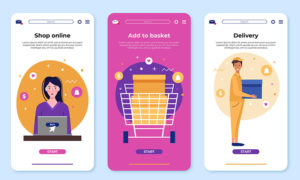In today’s digital era, mobile devices have become an integral part of our daily lives. With a significant increase in mobile internet usage, it is crucial for e-commerce businesses to have a mobile-responsive website design. A responsive website adapts and adjusts its layout, content, and functionality to provide an optimal viewing experience across various devices, including desktops, tablets, and smartphones. Designing a mobile-first eCommerce website involves creating a user experience tailored specifically for mobile devices before expanding to larger screens. In this blog post, we will explore the benefits of adopting a mobile-first approach in eCommerce web design, discuss how to deliver a bespoke user experience, and delve into mobile responsive eCommerce web design trends for 2023 and beyond.
Understanding Mobile Responsive Web Design:
A responsive website design ensures that your online store looks and functions seamlessly across different screen sizes and resolutions. It eliminates the need for creating separate versions of your website for different devices, saving time, effort, and resources. By utilizing flexible grids, fluid images, and media queries, a responsive web design ensures that your website automatically changes its layout and content to fit any screen size.

Benefits of Mobile Responsive Designs for Ecommerce Businesses:
- Enhanced User Experience (UX): A seamless and user-friendly experience is paramount for the success of any ecommerce business. A mobile-responsive design provides a consistent and intuitive user experience, irrespective of the device being used. It enables users to easily navigate, browse products, and make purchases, leading to increased customer satisfaction and reduced bounce rates.
- Increased Mobile Traffic and Conversions: With the proliferation of smartphones, mobile traffic has surpassed desktop traffic in recent years. A mobile-responsive website design ensures that your ecommerce store is easily accessible and optimized for mobile users. This leads to higher mobile search rankings, improved visibility, and increased organic traffic. Moreover, a responsive design facilitates a smooth checkout process, reducing cart abandonment rates and boosting conversions.
- Cost-Effectiveness: Investing in a mobile-responsive website design eliminates the need for creating and managing separate websites for different devices. This significantly reduces development, maintenance, and updating costs. Furthermore, a responsive design ensures that your ecommerce store is future-proof, as it can easily adapt to new devices and screen sizes.
- Improved SEO Performance: Search engines prioritize mobile-friendly websites in their search results. A mobile-responsive design enhances your website’s search engine optimization (SEO) performance, leading to higher rankings and increased organic traffic. By consolidating your web presence into a single responsive site, you can focus your SEO efforts on a single domain, improving your website’s overall visibility and authority.
- Improved Website Performance: Mobile-first design principles emphasize performance optimization, as mobile users often have limited bandwidth and slower internet connections. By focusing on mobile optimization, including fast loading times and efficient use of resources, you can provide a smooth and hassle-free experience for your customers, increasing their satisfaction and likelihood of repeat visits.

Responsive Design vs. Adaptive Design: What’s Better for Your Ecommerce Website?
While responsive design is widely recommended for ecommerce businesses, adaptive design is another approach worth considering. Here’s a brief comparison:
Responsive Design:
- Fluid and flexible layout that adapts to any screen size.
- Single website that adjusts to various devices.
- Requires a mobile-first approach for optimal results.
- Content and design elements rearrange automatically.
- Provides a consistent user experience across devices.
Adaptive Design:
- Multiple layouts created for specific devices or screen sizes.
- Requires more development and maintenance efforts.
- Customized content and design for each device type.
- Provides a tailored user experience for specific devices.
- May have higher upfront costs but offers precise control over user experiences.
Ultimately, the choice between responsive and adaptive design depends on your specific ecommerce business requirements, target audience, and budget.

You may also love to read about –
Choosing the Ideal Platform for Your E-Commerce Business
Strategies:
To maximize the benefits of mobile-responsive designs for your ecommerce business, partnering with UI/UX design agencies can be instrumental. This agency possess the expertise to create visually appealing, user-centric, and conversion-focused websites. They can implement the following strategies:
- User Research and Persona Development: UI/UX design agency conduct thorough user research to understand your target audience’s needs, preferences, and behaviors. This helps in creating user personas and tailoring the design and content to meet their expectations.
- Responsive Design Implementation: UI/UX design agencies have the technical know-how to develop and implement mobile-responsive designs that seamlessly adapt to various devices. They ensure optimal user experiences across all touchpoints of your ecommerce website.
- Conversion Rate Optimization (CRO): Digital marketing agencies can analyze user behavior and optimize your ecommerce website for higher conversions. By employing A/B testing, heatmaps, and user feedback, they can refine the design, layout, and functionality to drive more sales and revenue.
- Mobile SEO and Performance Optimization: Digital marketing agency specialize in optimizing websites for search engines and improving loading speed and performance. They can enhance your ecommerce website’s mobile SEO, ensuring higher visibility and better user experiences.

Delivering Bespoke User Experience Through Your eCommerce Site:
- Personalization: Utilize data-driven insights and customer segmentation to deliver personalized product recommendations, tailored content, and customized shopping experiences. Leverage technologies such as artificial intelligence and machine learning to understand customer preferences and deliver relevant content and offers.
- Streamlined Checkout Process: Simplify the checkout process by minimizing steps, enabling guest checkouts, and integrating popular payment gateways. Implement features like auto-fill, saved payment information, and real-time order tracking to enhance convenience and reduce cart abandonment rates.
- Responsive Customer Support: Offer seamless customer support through live chat, chatbots, or AI-powered virtual assistants. Provide quick responses to queries, facilitate easy returns and exchanges, and maintain consistent communication throughout the customer journey.

Mobile Responsive eCommerce Web Design Trends for 2023 and Beyond:
- Progressive Web Apps (PWAs): PWAs combine the best of mobile apps and websites, providing an app-like experience directly through a web browser. They offer fast loading, offline functionality, and push notifications, enhancing user engagement and retention. Collaborating with a mobile app development agency can help you leverage the benefits of PWAs for your eCommerce business.
- Voice Commerce: With the rise of voice assistants like Siri, Alexa, and Google Assistant, voice commerce is gaining traction. Integrating voice search and voice-controlled shopping experiences into your mobile-first eCommerce website can provide a convenient and hands-free shopping experience for customers.
- Augmented Reality (AR): AR technology allows customers to visualize products in their physical environment before making a purchase. By implementing AR features in your mobile-responsive eCommerce website, you can enhance the shopping experience, reduce returns, and increase customer satisfaction.
- Microinteractions: Microinteractions are subtle animations or interactions that provide feedback and enhance user engagement. Incorporating microinteractions into your mobile-responsive eCommerce website can make the shopping experience more interactive and enjoyable.
- Thumb-Friendly Navigation: With the majority of mobile users relying on one-handed navigation, optimizing your website’s navigation for thumbs is crucial. Place important navigation elements within reach of the user’s thumb, making it easier to navigate through the site.
- Minimalist Design: Minimalist design focuses on simplicity, clean layouts, and ample whitespace. It creates a visually pleasing and clutter-free experience on mobile devices, allowing users to focus on the key elements and products.
- Dark Mode: Dark mode has gained popularity in recent years and is expected to continue as a trend. Providing a dark mode option for your mobile-responsive eCommerce website can improve readability, conserve battery life, and offer a visually appealing experience.
- Interactive Product Visuals: Enhance the product experience by incorporating interactive visuals, such as 360-degree product views or zoom-in capabilities. This allows mobile users to examine products in detail and make more informed purchasing decisions.
- Mobile Video Content: Video content consumption on mobile devices is on the rise. Utilize videos to showcase product demonstrations, testimonials, or behind-the-scenes footage, creating an immersive and engaging experience for mobile users.
- Social Commerce Integration: Social media platforms have become powerful sales channels. Integrating social commerce features, such as shoppable posts and social login options, into your mobile-responsive eCommerce website can tap into the social media-driven purchasing behavior of mobile users.
- Personalized Push Notifications: Leveraging push notifications can help you engage and retain mobile users. Implement personalized push notifications to send tailored offers, product recommendations, or abandoned cart reminders, driving conversions and fostering customer loyalty.
- Voice Search Optimization: Voice search is becoming increasingly popular with the rise of virtual assistants. Optimize your mobile-responsive eCommerce website for voice search by implementing structured data, natural language processing, and voice-friendly content to capture voice-driven queries and attract mobile users.
- Mobile Wallet Integration: As mobile payments continue to gain traction, integrating popular mobile wallet options, such as Apple Pay, Google Pay, or PayPal, into your mobile-responsive eCommerce website provides a seamless and convenient checkout experience for mobile users.
- Accessibility and Inclusive Design: Consider accessibility features and inclusive design principles when creating your mobile-responsive eCommerce website. Ensure that the site is accessible to users with disabilities, with features such as alternative text for images, proper color contrast, and keyboard navigation support.

Conclusion:
Mobile-responsive web design has become a necessity for ecommerce businesses looking to thrive in the digital landscape. By providing an enhanced user experience, increasing mobile traffic and conversions, reducing costs, and improving SEO performance, responsive designs offer numerous benefits. By collaborating with digital marketing agencies, you can implement effective strategies to create compelling, user-centric, and conversion-driven ecommerce websites. Embrace mobile responsiveness today and stay ahead of the competition in the rapidly evolving world of ecommerce.



















